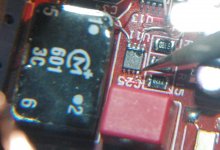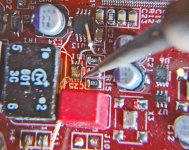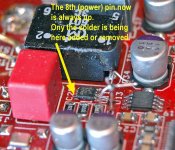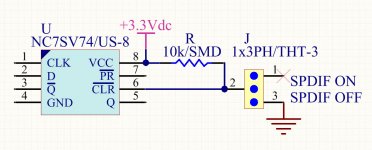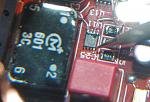Well, I'm not a MAC user but I'll see what I can do about it. For them moment my wish is to gather some info on how to update WaveIO on MAC too. I hope my post will help you and if you are going to make the update please tell me about your progress!
Kind regards!
It seems we are all Mac users up here in the North 🙂 At least for music
playback. I suppose the revision is just as important under Mac so how
do i find out what revision I have on my waveio under Mac, is that even
possible ?
Edit: Never mind, I found it.
Product id: 0x4143
Manufacturer id:0x20a0
Version: 3.31
Serial: 0330
Is "RevisionID (0x)0331" the same as "version 3.31" ?
Last edited:
Hi Lucian,
thanks for sharing the DSD-FW!
Some points on my system (Mac with Yosemite):
- You changed the name of the WaveIO (or it would be recognized with a wrong name)!?
- another DAC would be recognized correctly with DSD functionality, the WaveIO not (i can choose of two presets manually setups but then i hear then some "ticks" in the playback), DSD capability not shown in the player (Audirvana Plus)
- the biggest problem is for me that 384khz not more possible is! If i sect on my system resampling to max (32bit/384khz) there is not playback anymore.
How can i help you to fix these?
thanks for sharing the DSD-FW!
Some points on my system (Mac with Yosemite):
- You changed the name of the WaveIO (or it would be recognized with a wrong name)!?
- another DAC would be recognized correctly with DSD functionality, the WaveIO not (i can choose of two presets manually setups but then i hear then some "ticks" in the playback), DSD capability not shown in the player (Audirvana Plus)
- the biggest problem is for me that 384khz not more possible is! If i sect on my system resampling to max (32bit/384khz) there is not playback anymore.
How can i help you to fix these?
Attachments
Yes! just ignore the Serial # since it's not taken into account here not it will be!Is "RevisionID (0x)0331" the same as "version 3.31" ?
@ Carsten: Still work on MAC side! 😱
Hello Lucian and all colleagues,
I am using Lorien usb/i2s converter with my different DAC's since spring 2013 using Windows7 32-bit on Lenovo S12" netbook and (mainly) Foobar2000 as a player.
Everything is OK and the board works perfectly!
This time I have non-typical hardware question: is it possible to easily switch-off the SPDIF signal from XMOS?
I mean a comfortable switching-on/off the signal processing inside the XMOS, not simply powering-off/on NC7SV74 driver before SPDIF transformer (+Vcc pin-up). This is the only "primitive" method I am using now.
When using i2s output it gives slightly better sound.
When using old DACs with SPDIF signal input - I simply solder the 8th pin of NC7SV74 back to +Vcc.
Anybody tried this kind of improvement?
Best regards, Piotr.
I am using Lorien usb/i2s converter with my different DAC's since spring 2013 using Windows7 32-bit on Lenovo S12" netbook and (mainly) Foobar2000 as a player.
Everything is OK and the board works perfectly!
This time I have non-typical hardware question: is it possible to easily switch-off the SPDIF signal from XMOS?
I mean a comfortable switching-on/off the signal processing inside the XMOS, not simply powering-off/on NC7SV74 driver before SPDIF transformer (+Vcc pin-up). This is the only "primitive" method I am using now.
When using i2s output it gives slightly better sound.
When using old DACs with SPDIF signal input - I simply solder the 8th pin of NC7SV74 back to +Vcc.
Anybody tried this kind of improvement?
Best regards, Piotr.
Hello Piotr,
thank you for your kind words! I would strongly advice against desoldering too many times that VCC pin of the Flip-Flop chip otherwise you can damage the part. I didn't thought at On/Off switch for SPDIF but if you really need one solution then I'll look for it!
Kind regards,
L
thank you for your kind words! I would strongly advice against desoldering too many times that VCC pin of the Flip-Flop chip otherwise you can damage the part. I didn't thought at On/Off switch for SPDIF but if you really need one solution then I'll look for it!
Kind regards,
L
Hi again, Lucian.
Of course, you are right. The desoldering procedure here is always very risky. To perform it from time to time I use: good desoldering braid, magnifyiyng glass and a special tip for soldering iron. Pls see photos attached.
Soldering back is much more easier. Small drop of a solder at the iron's tip is enough...
Much easier and better would be switching on/off the SPDIF coding process with XMOS processor itself. Digital noises together with some power supply would be also saved 🙂
My discribed method is risky & primitive as SPDIF signal is still outside XMOS. Only the signal path is shorter. Anyway, the "cleaner I2S" music effect is always slightly better: the resolution is higher and timbre of voices is more natural.
The above effect does NOT mean that XMOS-generated SPDIF signal is bad. Sometimes, for testing different DAC's equipped with SPDIF input only, I switch-on the power for NC7SV74 and I connect SPDIF cables to the trafo output. The quality of music decoded from PC-USB and coded to SPDIF is still very good.
Regards,
Piotr
Of course, you are right. The desoldering procedure here is always very risky. To perform it from time to time I use: good desoldering braid, magnifyiyng glass and a special tip for soldering iron. Pls see photos attached.
Soldering back is much more easier. Small drop of a solder at the iron's tip is enough...
Much easier and better would be switching on/off the SPDIF coding process with XMOS processor itself. Digital noises together with some power supply would be also saved 🙂
My discribed method is risky & primitive as SPDIF signal is still outside XMOS. Only the signal path is shorter. Anyway, the "cleaner I2S" music effect is always slightly better: the resolution is higher and timbre of voices is more natural.
The above effect does NOT mean that XMOS-generated SPDIF signal is bad. Sometimes, for testing different DAC's equipped with SPDIF input only, I switch-on the power for NC7SV74 and I connect SPDIF cables to the trafo output. The quality of music decoded from PC-USB and coded to SPDIF is still very good.
Regards,
Piotr
Attachments
I took the plunge recently and ordered a WaveIO.
It's now plumbed alongside my Najda DSP DAC/X/O solution and making very nice sounds indeed at all sample rates (I only have upto 192000🙂 ).
Thanks to Lorien for supply and support and a special thanks to JLOP for a great descriptive pin to pin wiring diagram for WaveIO to Najda.
Next up is install it so it looks nice, as well as sounds nice.
It's now plumbed alongside my Najda DSP DAC/X/O solution and making very nice sounds indeed at all sample rates (I only have upto 192000🙂 ).
Thanks to Lorien for supply and support and a special thanks to JLOP for a great descriptive pin to pin wiring diagram for WaveIO to Najda.
Next up is install it so it looks nice, as well as sounds nice.
Even if you say your procedure is "risky & primitive" it does have good results, isn't it? 🙂 I would do the same if I were in your place just because the other approach I have in mind is involving firmware and will not be so pleasant and easy accessible thus I'll not recommend it.Hi again, Lucian.
Of course, you are right. The desoldering procedure here is always very risky. To perform it from time to time I use: good desoldering braid, magnifyiyng glass and a special tip for soldering iron. Pls see photos attached.
Soldering back is much more easier. Small drop of a solder at the iron's tip is enough...
Much easier and better would be switching on/off the SPDIF coding process with XMOS processor itself. Digital noises together with some power supply would be also saved 🙂
My discribed method is risky & primitive as SPDIF signal is still outside XMOS. Only the signal path is shorter. Anyway, the "cleaner I2S" music effect is always slightly better: the resolution is higher and timbre of voices is more natural.
The above effect does NOT mean that XMOS-generated SPDIF signal is bad. Sometimes, for testing different DAC's equipped with SPDIF input only, I switch-on the power for NC7SV74 and I connect SPDIF cables to the trafo output. The quality of music decoded from PC-USB and coded to SPDIF is still very good.
Regards,
Piotr
Even if lifting the power pin is the best choice here, you can also try your DIY skills with the CLR pin of that FF. I mean to leave the power at its place, lift the CLR (pin 6) and solder a thin wire to it.
Stabilize that wire on something to not go away with the 6th pin from the chip and solder a pull-up (10K) resistor to it... pull-up wired to any 3.3Vdc PSU you'll find nearby (see picture attached).
When you put CLR to ground = bye SPDIF otherwise (leaved floating) you have SPDIF signal on output(s).
After I saw what you did on your Wave board I'm sure you'll enjoy it! More than this, if you get into troubles I'm here to back you up... just be careful though! 😱
@Speedysteve7: Thank you! 🙂
Attachments
The WAVEIO in I2S sounds great.
Thanks Lucian!
I use one 5V power supply for the DAC and WAVEIO.
Is separate power supplies for each unit is recommended?
And what power supply do you recommend?
Thanks Lucian!
I use one 5V power supply for the DAC and WAVEIO.
Is separate power supplies for each unit is recommended?
And what power supply do you recommend?
Crackling in one channel
I bought a WAVEIO from DDDAC about a year ago to interface with their PCM1794 DAC. It has performed flawlessly until a couple days when one channel started intermittent crackling with reduced sound level. The other channel is still pristine. Sometimes the crackling is overwhelming and doesn't stop when I unplug the USB cable or turn off the computer music source (JRiver). Cycling the power to the DAC/WaveIO unit restores silence.
I have replaced the USB cable, reseated all the I2S cable connections, and installed the latest WaveIO driver.
What should I try next? Thanks.
I bought a WAVEIO from DDDAC about a year ago to interface with their PCM1794 DAC. It has performed flawlessly until a couple days when one channel started intermittent crackling with reduced sound level. The other channel is still pristine. Sometimes the crackling is overwhelming and doesn't stop when I unplug the USB cable or turn off the computer music source (JRiver). Cycling the power to the DAC/WaveIO unit restores silence.
I have replaced the USB cable, reseated all the I2S cable connections, and installed the latest WaveIO driver.
What should I try next? Thanks.
Thank you! 🙂 Yes, please use separate PSU for WaveIO and try to avoid USB bus powering: basically consider it doesn't exists!The WAVEIO in I2S sounds great.
Thanks Lucian!
I use one 5V power supply for the DAC and WAVEIO.
Is separate power supplies for each unit is recommended?
And what power supply do you recommend?
As for PSUs, there are many out there but one was built especially for WaveIO by my friend Doede. You can find it here.
There are few things to try out before sending it back to me:I bought a WAVEIO from DDDAC about a year ago to interface with their PCM1794 DAC. It has performed flawlessly until a couple days when one channel started intermittent crackling with reduced sound level. The other channel is still pristine. Sometimes the crackling is overwhelming and doesn't stop when I unplug the USB cable or turn off the computer music source (JRiver). Cycling the power to the DAC/WaveIO unit restores silence.
I have replaced the USB cable, reseated all the I2S cable connections, and installed the latest WaveIO driver.
What should I try next? Thanks.
1. the first among them that comes to my mind is to bypass the isolator. Shorting all inputs with outputs in actual configuration will not be enough so I would recommend to use the pads from the miniBNCs to carry I2S signal to your DAC chip(s). Please do that for testing only and look if that crackling is still present!
The signals' names are clearly visible on the TOP silk screen so there should be no problem regarding that!
2. make sure that all your I2S wires are of the same length!
3. Try to remove the IDC connector (the one used for J6 PH) several times and put it back (just to minimize or defeat any parasitic resistances those conns might have!). Use isopropyl alcohol if needed.
4. Make sure you do (3.) to the other end of DDDAC board.
Please keep me posted,
L
Last edited:
Hello Lucian and all colleagues,
When using i2s output it gives slightly better sound.
Anybody tried this kind of improvement?
Best regards, Piotr.
Piotr & Lucian
I will never have a use for SPIFD and always strive for best possible sound. If I attempt to permenantly disable the chip by lifting pin 8, if I goof and end up removing the chip completely from the PCB, is there any downside to function of I2s?
I have had good results by removing 'optional' components from DAC leaving only the ones that I need for my particular application. I appreciate this tip.
Walter
Piotr & Lucian
I will never have a use for SPIFD and always strive for best possible sound. If I attempt to permenantly disable the chip by lifting pin 8, if I goof and end up removing the chip completely from the PCB, is there any downside to function of I2s?
I have had good results by removing 'optional' components from DAC leaving only the ones that I need for my particular application. I appreciate this tip.
Walter
Hello Walter! There's nothing wrong to remove that IC as it's doesn't have any ties with the I2S bus, only with SPDIF. Due to small package (for some) you have to take a little bit more care not to make short circuits or even damage the PCB.
Kind regards,
L
SPIFD ectomy Success
Thanks for the tip Piotr. Base on your report, I took the plung and removed U11, effectively removing SPIFD from WaveIO to make it dedicated to producing best possible I2S signal..
Outstanding!. Improvement is not subtle. WaveIO was always great. Now Outstanding.
There is a significant sharpening of every sound in 3d space, and an improvement in micro detail and dynamics.
I have a well resolved system. Improvements in source are evident. In this case everything sharper and more focused and 3d. Slight digital edge removed taking one step closer to analogue. More and better defined bass. Complicated busy music that was previously muddled is now perfectly defined layers in 3d. As Piotr described, voices and treble even more natural. 😀
The chip is tiny. How Lorian assembles these by hand is beyond me. So clearly care is required. With strong magnifying glass and good light I can not imagine desoldering the #8 leg. So I simply carefully pried the entire IC off with a flat screw driver. It popped right off clean. Then checked carefully for no shorts. Powered it up and Nirvana.
I am sure you risk destroying your board, so proceed at your own risk. I think when ordering your board, if you have no need for SPIFD, you should ask Lorian to leave U11 off the build.
Thanks for the tip Piotr. Base on your report, I took the plung and removed U11, effectively removing SPIFD from WaveIO to make it dedicated to producing best possible I2S signal..
Outstanding!. Improvement is not subtle. WaveIO was always great. Now Outstanding.
There is a significant sharpening of every sound in 3d space, and an improvement in micro detail and dynamics.
I have a well resolved system. Improvements in source are evident. In this case everything sharper and more focused and 3d. Slight digital edge removed taking one step closer to analogue. More and better defined bass. Complicated busy music that was previously muddled is now perfectly defined layers in 3d. As Piotr described, voices and treble even more natural. 😀
The chip is tiny. How Lorian assembles these by hand is beyond me. So clearly care is required. With strong magnifying glass and good light I can not imagine desoldering the #8 leg. So I simply carefully pried the entire IC off with a flat screw driver. It popped right off clean. Then checked carefully for no shorts. Powered it up and Nirvana.
I am sure you risk destroying your board, so proceed at your own risk. I think when ordering your board, if you have no need for SPIFD, you should ask Lorian to leave U11 off the build.
Outstanding!. Improvement is not subtle. WaveIO was always great. Now Outstanding.
Thank Walter for your listening report, it's really interesting for a i2s WaveIO user like me. I'd prefer to keep spdif output enabled, so Lucian scheme (#2130) should be the way to go, in my view. I tried to lift pin #6 but it's impossibile to do that with my skills. I can do easily with bigger chips, prying the leg with a pin while desoldering, but this chip is too tiny. Your solution seems to be the only feasible way for me.
Thank Walter for your listening report, .... Your solution seems to be the only feasible way for me.
My pleasure. I am a big fan of WaveIO, and had no idea it was possible to squeeze a little more out. I should have taken a picture of the board after the operation and it may be a while before I am back in there. To be clear, U11 is the tiny square IC that Piotr points at with his fine point soldering iron.
My soldering iron is the size of the entire IC, so no way to lift a pin. I figured that worst case, a couple of legs would be left behid that could short out the pcb. If that had happened, I think it would be pretty easy to clean itup with solder removing braid. But no worries, the legs stayed with the IC and snapped off clean on the pcb.
Attachments
Thank for the picture, it explains very clearly what you did.
How are the pads on the board now? Can they be soldered again?
How are the pads on the board now? Can they be soldered again?
Guys, this is great feedback. I will be doing this if I can get the baby to go to sleep for 30 minutes!!!
Anyway, in the meantime, do be very careful about prying that chip off as the tracks may get damaged. It's a little extra money but this is very useful and I seem to remember you used to be able to order samples from them. It makes removing chips like that a doddle:
The Chip Quik SMT Rework Newsletter
Hope this helps and I'll report back when I've lifted the leg!
Anyway, in the meantime, do be very careful about prying that chip off as the tracks may get damaged. It's a little extra money but this is very useful and I seem to remember you used to be able to order samples from them. It makes removing chips like that a doddle:
The Chip Quik SMT Rework Newsletter
Hope this helps and I'll report back when I've lifted the leg!
- Home
- Source & Line
- Digital Line Level
- XMOS-based Asynchronous USB to I2S interface

